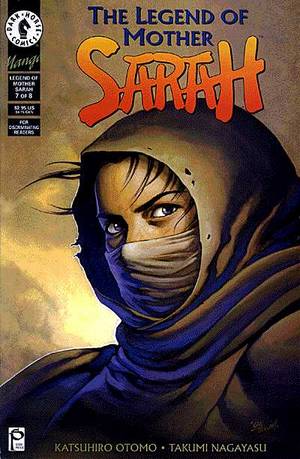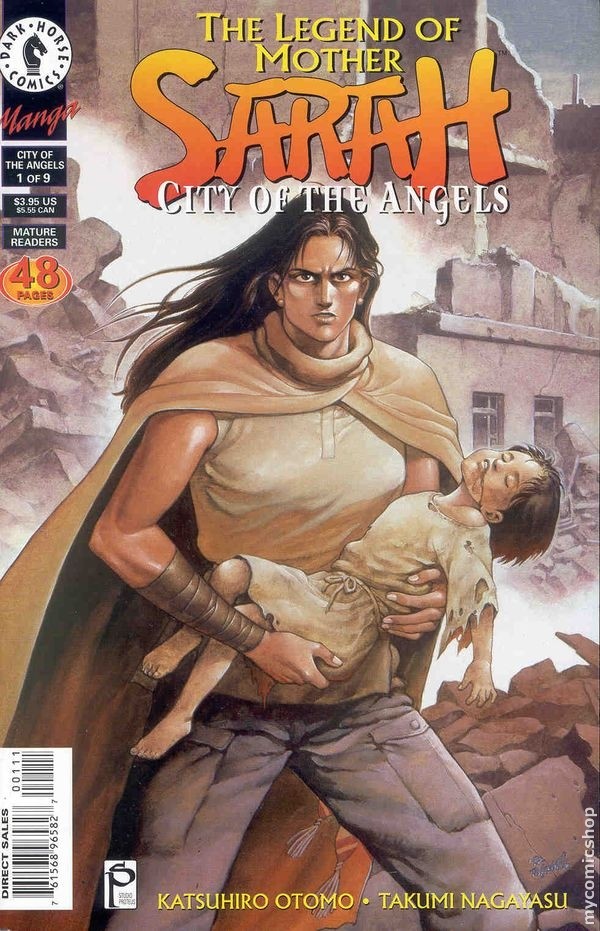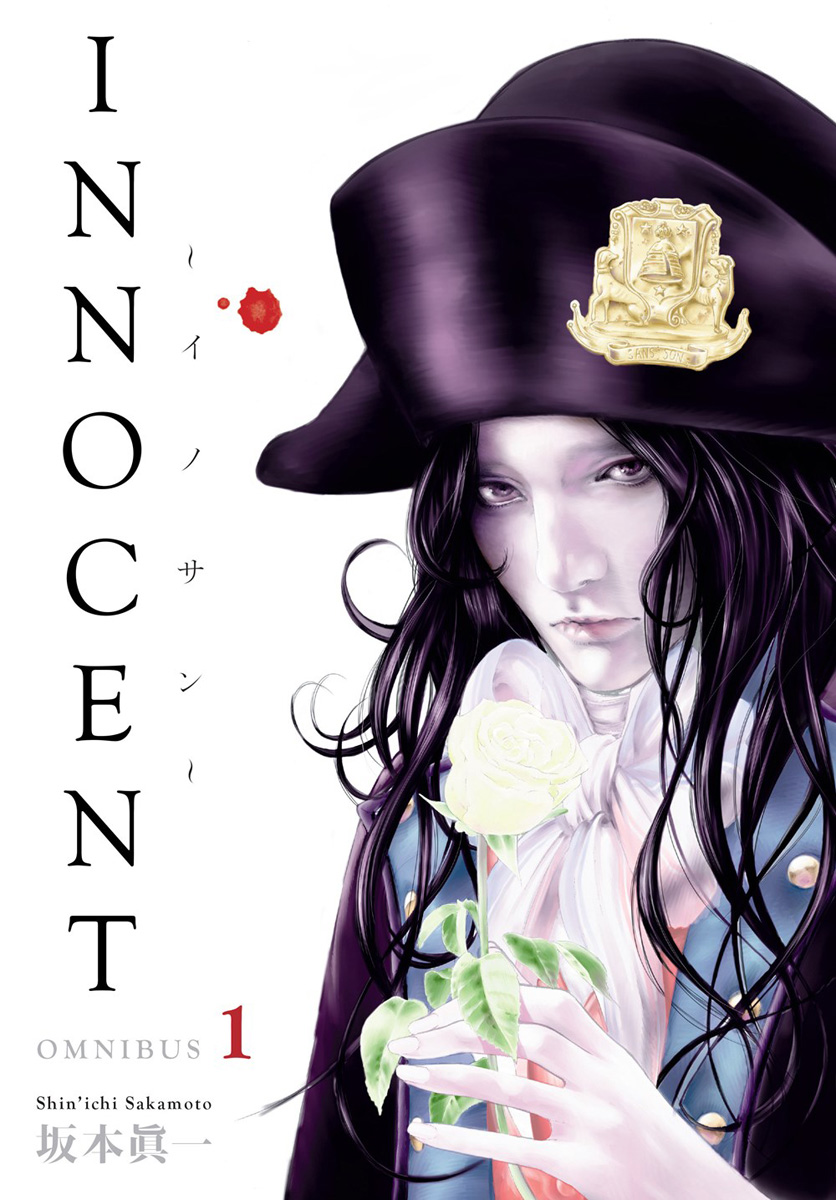Most American manga fans know Katsuhiro Otomo as the creative force behind AKIRA and Domu: A Child’s Dream, but Otomo’s catalog also includes works like The Legend of Mother Sarah, in which Otomo penned the script but relinquished the illustration duties to another manga-ka. And while Mother Sarah isn’t quite as visually dazzling as AKIRA or Domu, this post-apocalyptic adventure is every bit as fun to read, thanks to its vivid characterizations and dynamic action sequences.
Set in the not-too-distant future, Mother Sarah begins in space — or, more accurately, space stations, where the survivors of a nuclear holocaust have sought refuge from the Earth’s extreme climate changes. When riots threaten the peace aboard these floating cities, the military evacuates civilians back to the surface, in the process separating thousands of children from their parents. Sarah, the story’s eponymous heroine, is on a quest to find her own family, all of whom disappeared in the chaos aboard the space stations. Traveling with Tsue, a trader, she wanders a desolate landscape of crumbling cities, slave-labor camps, religious compounds, and hardscrabble farms, karate-chopping anyone who threatens the honest folk she meets along the way.
Given its classic premise and cool, resourceful heroine, it’s curious that Mother Sarah had such a short shelf life here in the United States. As tempting as it may be to chalk up fan indifference to sexism, or antipathy towards Otomo’s other (read: not AKIRA) projects, I think the real reason lies with the way Mother Sarah was released. Dark Horse published the series from 1995-98, but only collected the first eight issues into a trade paperback. When read in thirty-page installments, The Legend of Mother Sarah: Tunnel Town is engaging but frustrating. Otomo and artist Takumi Nagayasu’s sense of pacing, in particular, is too leisurely for a stand-alone booklet: they establish a new setting with a dozen wordless panels, luxuriate in an explosion, or depict a fist-fight over five or six pages, gobbling up real estate that might otherwise be advancing the story. Contrast an issue of Tunnel Town with that of a long-running American series and the incompatibility of format and story becomes more apparent. In each issue of The Walking Dead, for example, one important event is dramatized: the characters make a critical discovery about their zombie foes or confront a troublemaker within their ranks. Though the issue may end on a cliffhanger, there’s a sense of closure that’s missing from an issue of Mother Sarah, even though both stories are clearly intended to extend beyond the confines of a single pamphlet.
When read in trade paperback form, however, Tunnel Town has a more satisfying rhythm. Those establishing shots and slow-mo fight scenes draw the reader deeper into the story; we feel like we’re actually part of the scene, rather than passive witnesses to the action. The continuity between events is easier to appreciate as well. Sarah’s skirmishes with authority no longer seem like a string of isolated incidents, but a steadily escalating pattern of violence that demands resolution. And what a finale! Coming at the end of two hundred pages, the denouement is less a cool stunt than a thrilling affirmation of Sarah’s courage and smarts, an emphatic punctuation mark at the end of a long but well-reasoned paragraph.
I’m guessing that someone at Dark Horse must have thought Mother Sarah was ill-served by the thirty-page format, as the next two arcs — City of the Children and City of the Angels — were published in forty-eight page installments, a development highlighted on the front covers of each issue:
As a result, the later mini-series are more engaging; we’re treated to a larger, more satisfying chunk of story in each installment, a chunk that I suspect corresponds more closely to the way the manga was serialized in Young Magazine. Alas, neither Children nor Angels were collected in bound form, making it harder for a new generation of manga fans to discover the series for themselves.
For all my grumbling about format and scarcity, however, all three story arcs are worth owning, both for the art and the story. Takumi Nagayasu’s crisp visuals are pleasingly reminiscent of Otomo’s. Nagayasu’s characters are drawn in a naturalistic fashion, with plenty of attention given to hands, facial hair, posture, wrinkles, and muscles; even the most inconsequential soldier or civilian is given a unique face and a thoughtfully constructed costume. Nagayasu also shares Otomo’s love of vehicles and decaying urban landscapes, rendering both in a fine, evocative fashion; one can almost hear the steel structures rusting from neglect.
Otomo’s writing is as strong as Nagayasu’s artwork. Though Sarah is a certifiable bad-ass, capable of kicking and stabbing her way out of a tight situation, she relies on her wits just as frequently as her fists. Her maternal instincts, too, inform much of her decision-making; throughout the series, Sarah is drawn to conflicts involving exploited or abused children, offering her a chance to symbolically “save” the family she lost ten years earlier. In short, Sarah is a woman warrior in the Lt. Ellen Ripley/Sarah Connor mold: fierce, strong, principled, and, above all else, a mama grizzly who sides with the young and the helpless. Oh, and she looks good while dispensing justice, too. Now that’s my kind of escapism, no matter how it’s packaged.





Jade Harris says:
Ooo, I haven’t read this one!
It sounds like a great example of those strong female characters from 80s and 90s manga that I grew up on. You just don’t see characters like Sarah anymore.
Katherine Dacey says:
Hi, Jade—good to hear from you! I didn’t think it was possible for me to review an older title that you hadn’t read! 😉
I’d love it if Kodansha rescued Mother Sarah from licensing purgatory. The number of tough, mature female characters who star in their own sci-fi or action manga is pitifully low, and we need to address that deficiency stat. Lady Snowblood can’t be the only character shouldering that burden!
Caddy C says:
Woah, this looks awesome!
How many women (actual women, not girls!) do we get to see in action manga? Too few!
Katherine Dacey says:
No kidding! Plus Sarah actually dresses appropriately for her line of work. (That would be butt-kicking, if that wasn’t already obvious from my review.) There’s occasional nudity — it wouldn’t be seinen without some — but it doesn’t feel pandering or gratuitous, and we’re spared the endless parade of cleavage and panty shots.
The trade paperback is still pretty easy to come by — and cheap! — so I’d highly recommend looking for it. (I think TFAW.com has copies in stock, and Amazon probably does as well.) The first story arc is clearly setting the table for later adventures, but it works reasonably well as a stand-alone volume.
dm says:
I found the Tunneltown story collected as a graphic novel (in Million Year Picnic) ages ago, and enjoyed it a good deal. You’re right that it is a great post-apocalyptic story with some great side characters.
I never realized there was more until I stumbled across later volumes (in Japanese) in Book Off in NYC. I’ve tracked down the entire series (I think) in Japanese, but haven’t tried to tackle the volumes yet.
Katherine Dacey says:
Do you mean the Million Year Picnic in Harvard Square? I’ve scored some amazing manga finds in their bargain bins, including volumes of Eagle and Qwan. It’s always a hit-or-miss affair, but I’m always willing to give it a shot.
dm says:
The very same. Back when “manga” basically meant a handful of things from Viz and Dark Horse, I bought all my manga there. Now I mostly buy indie comics from them —- they’re the place that introduced me to Usagi Yojimbo, Scott Pilgrim, Andi Watson, Courtney Crumrin, Two-fisted tales of Science, Dignifying Science and almost all of my non-manga comics.
Katherine Dacey says:
I haven’t been to the Million Year Picnic in ages! My office is located just a few blocks from Comicopia, so I tend to do all my in-person manga purchasing there. It sounds like a trip to Harvard Square might be in order…
dm says:
I’m more-or-less the opposite. Comicopia is the “other side of town” for me —- I’m so provincial —- while MYP is a tolerable walk from home and work. It’s still the same tiny, cramped little store it’s always been. It does make pretty efficient use of its space. But there’s a Peet’s Coffee across the street for you to browse through your haul.
It’s manga collection is about half the size of a heyday Borders. Maybe 40 to 50 shelf-feet of mostly book spines?
Greg McElhatton says:
I miss Legend of Mother Sarah — I had that first collection for ages, in the hopes that Dark Horse would release some more, but of course it was never to be. *sigh* Hopefully one of these days it’ll get re-licensed for North America and given a proper release this time around. (Are you listening, publishers? Pllleeeeeaaassseee?)
Katherine Dacey says:
It would be nice if Kodansha published it, or licensed it to Vertical. I know Ed probably wouldn’t touch this franchise with a ten-foot pole — it doesn’t seem like his kind of manga — but I think Vertical could really do a lot for this series with big omnibus editions and snazzy covers. The covers on the original DH editions are pretty awful, and don’t convey the true awesomeness of the content, IMO.
eva_guy01 says:
I remember buying the complete series in its original Japanese paperback manga. At that time, the comic store was closing for good and it was on sale and nobody was touching it. I bought it because the art reminded me of Akira, and was I correct in assuming!
Eventually I stumbled into an online scanlation of the series (not Dark Horse, the original) and you guys should read that one without the edits from Dark Horse.